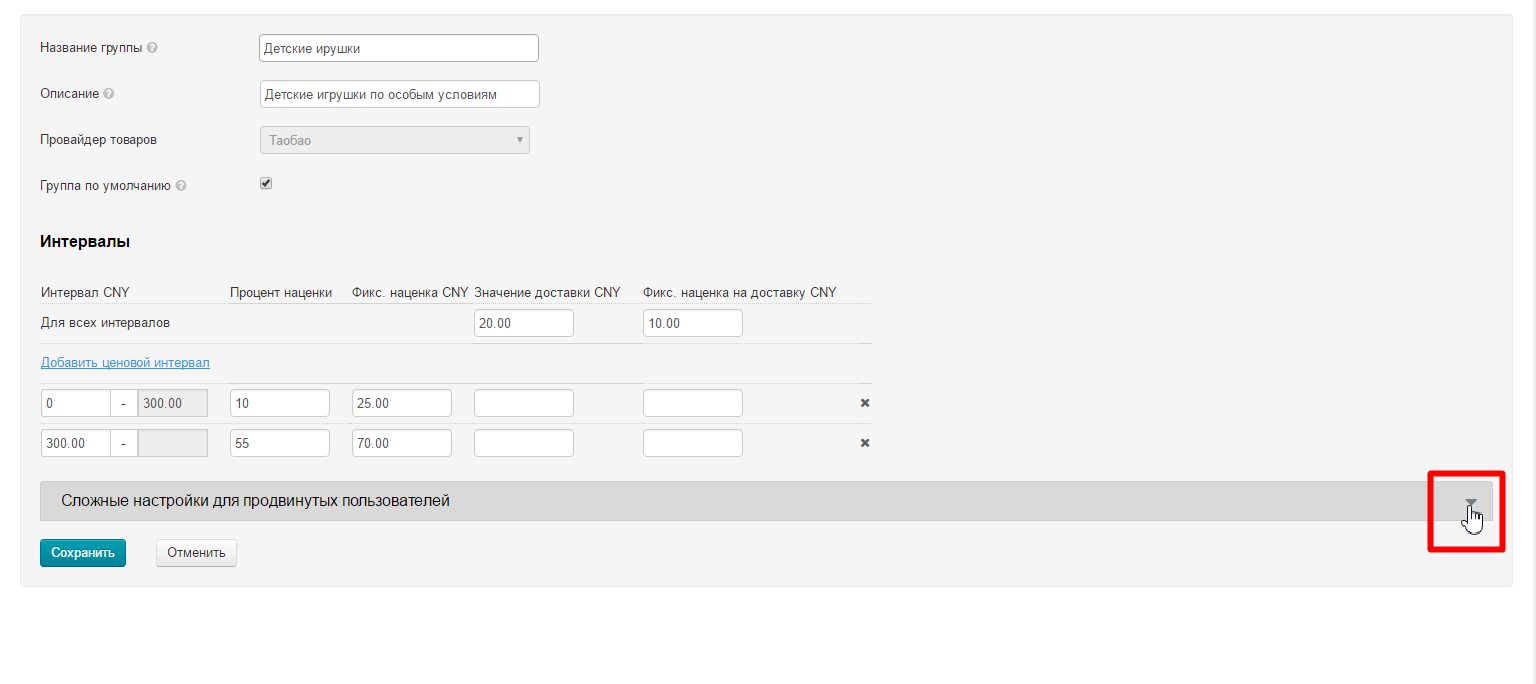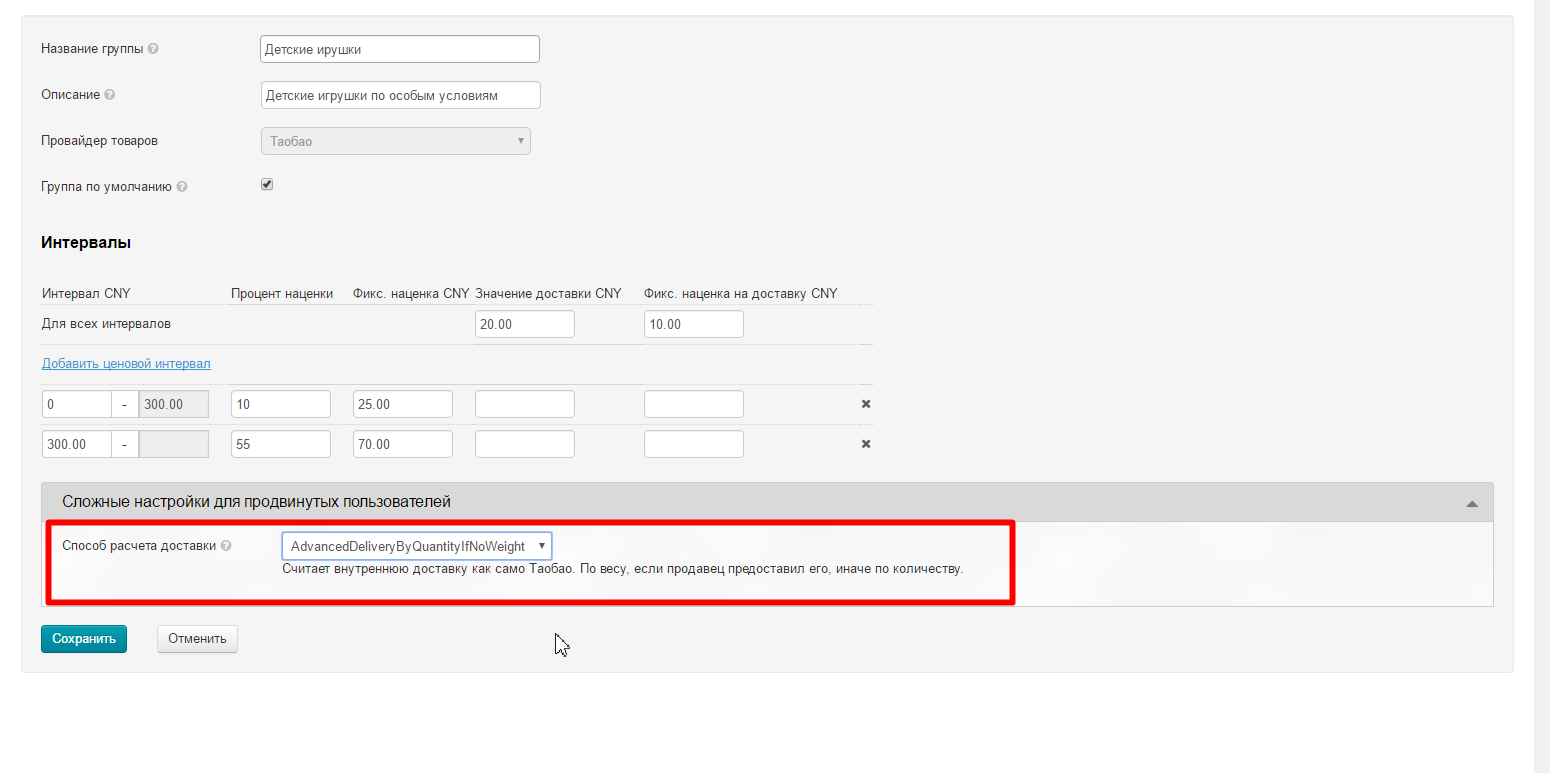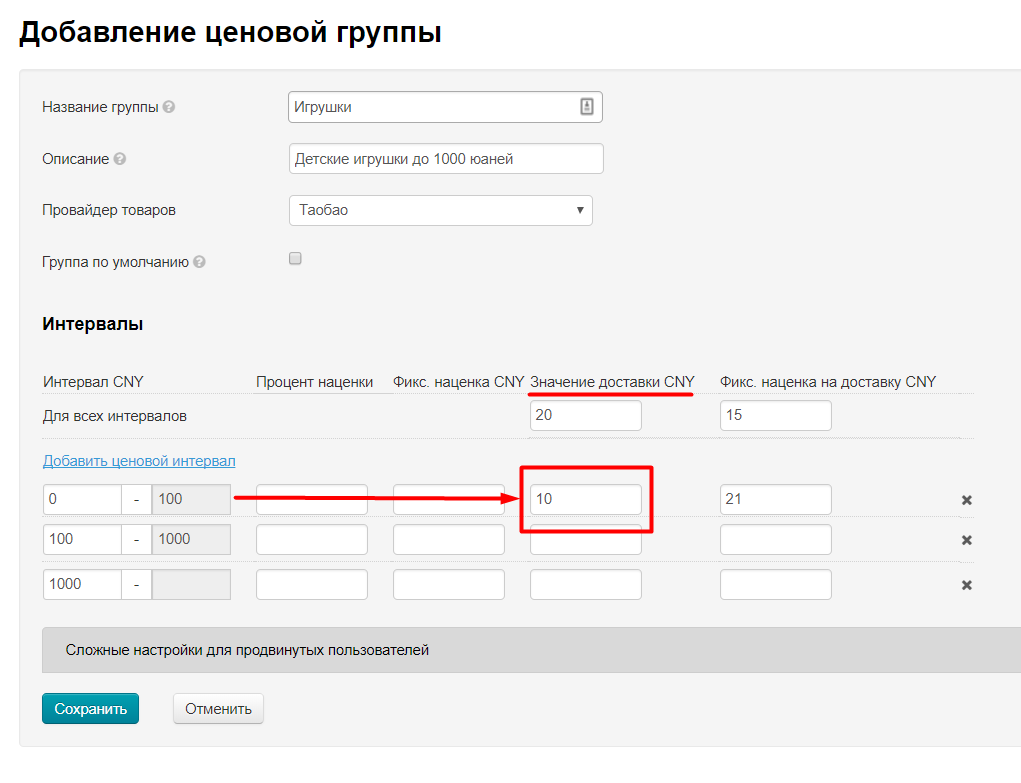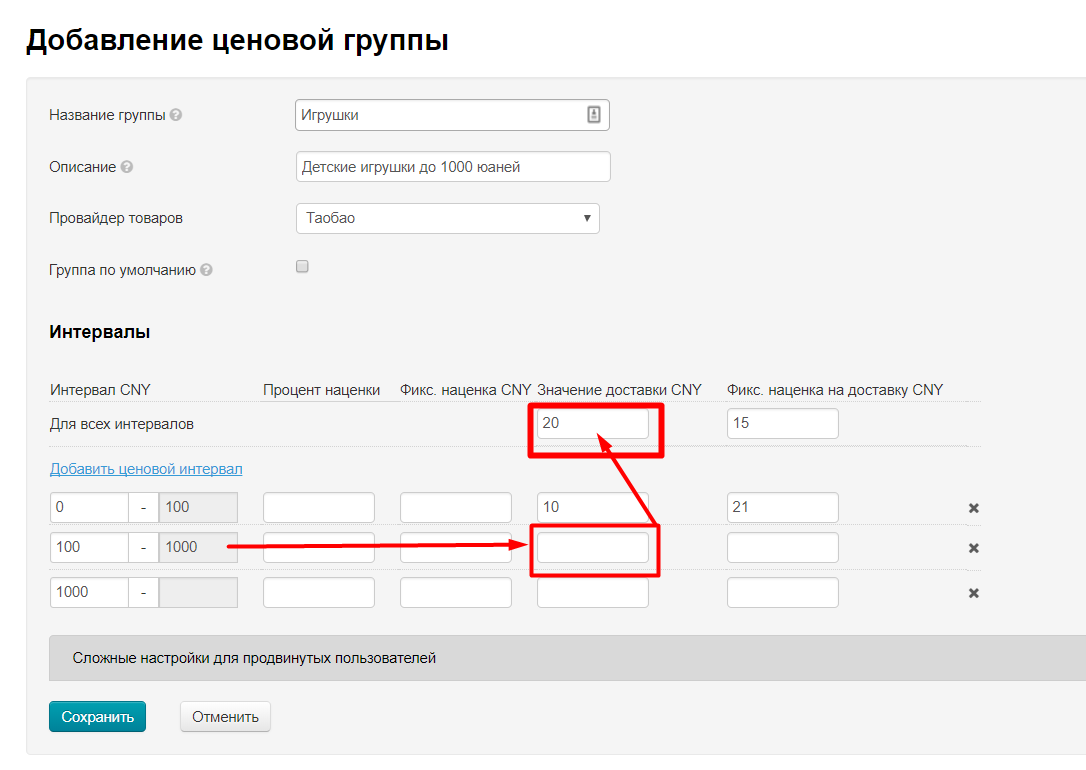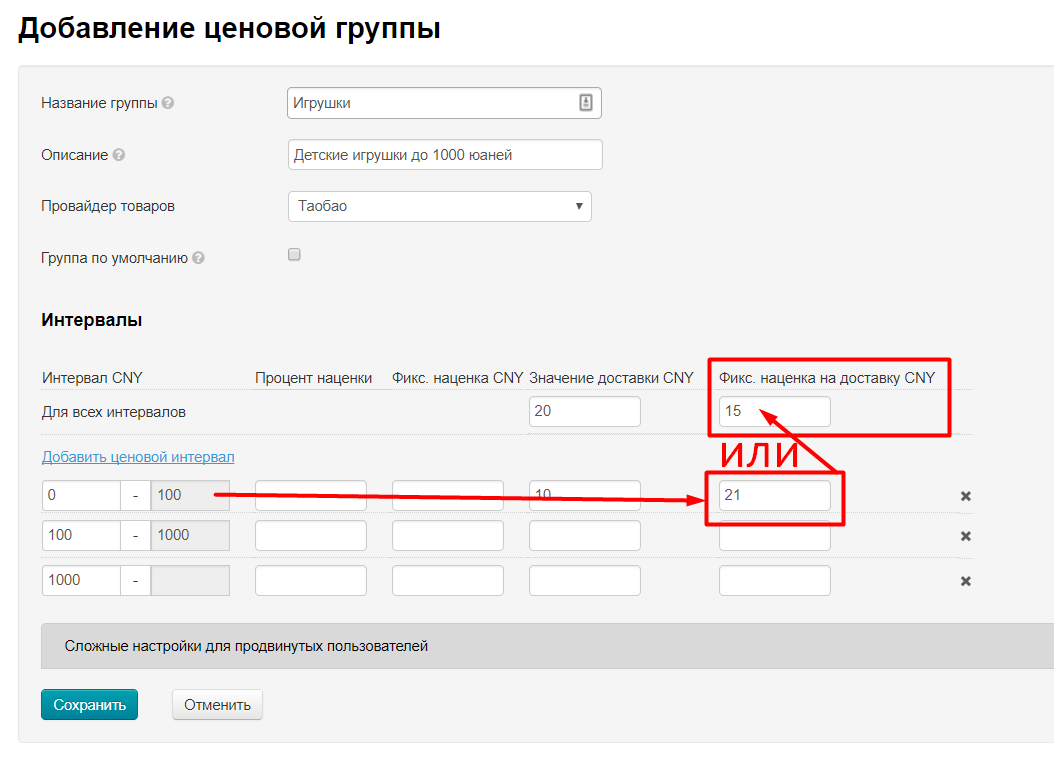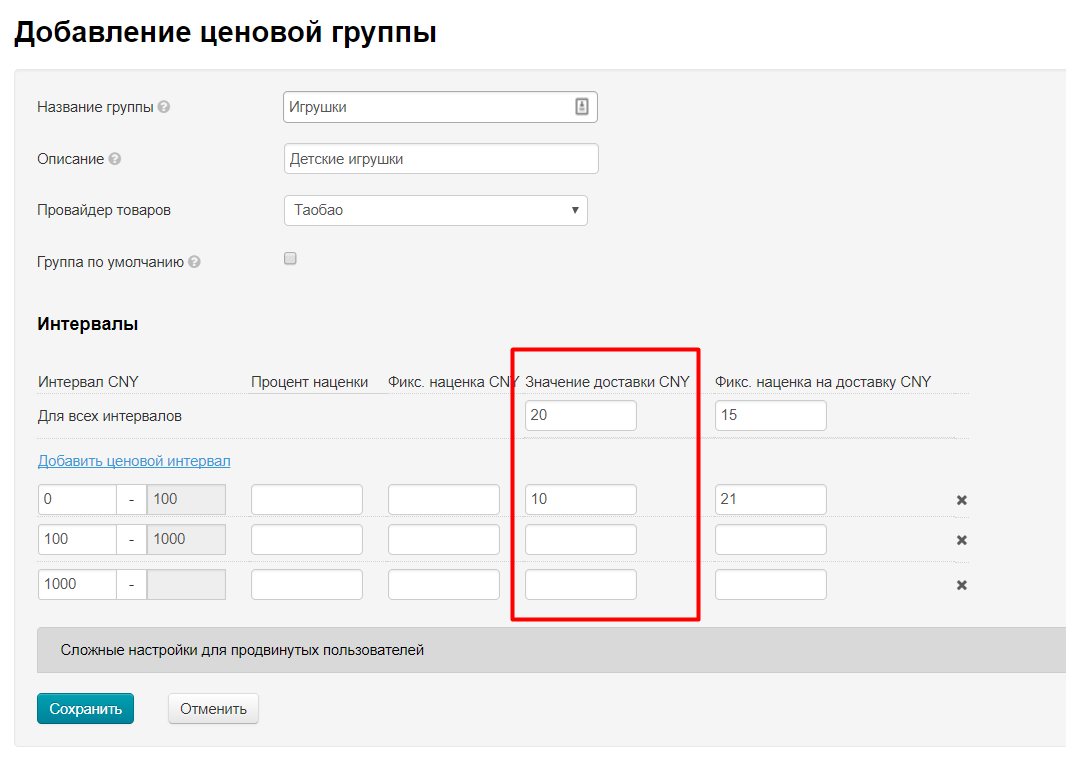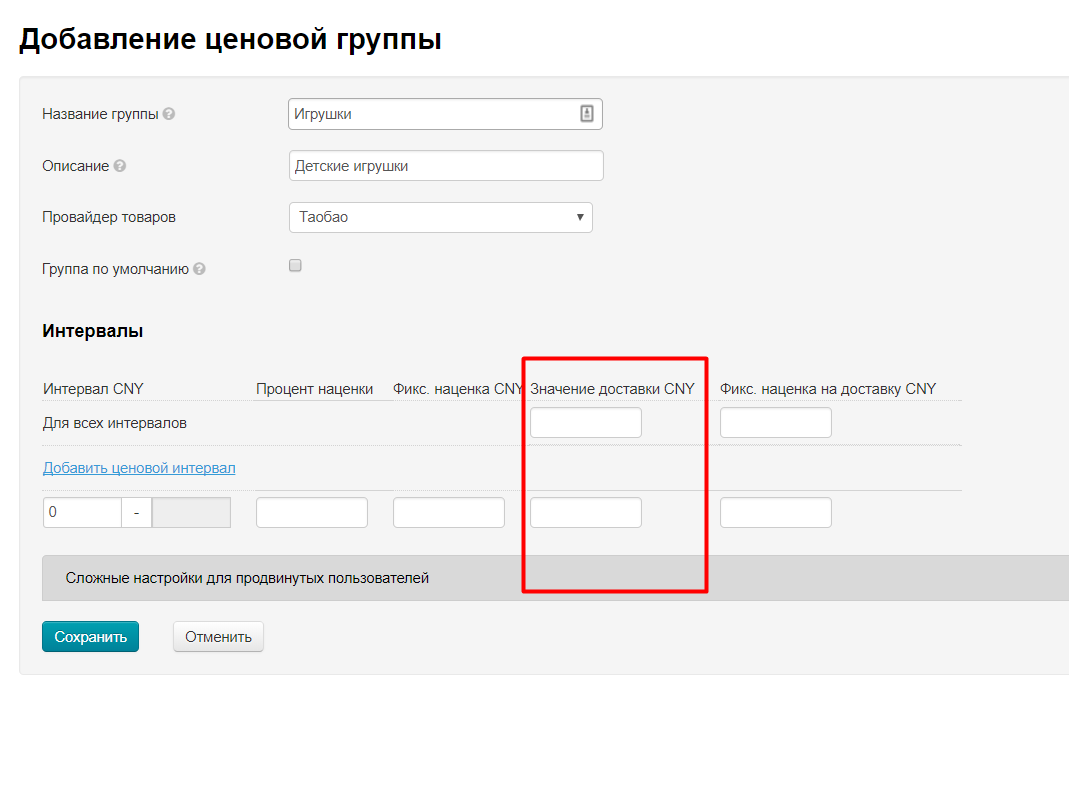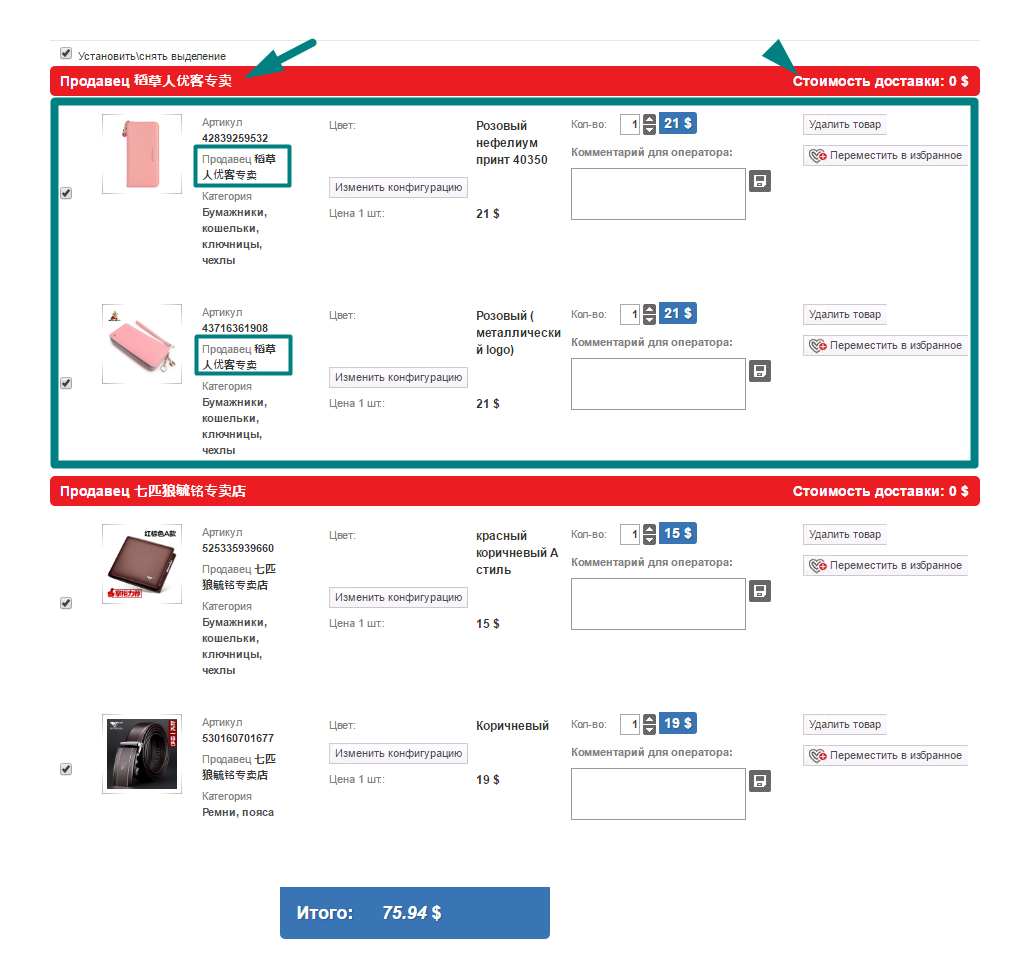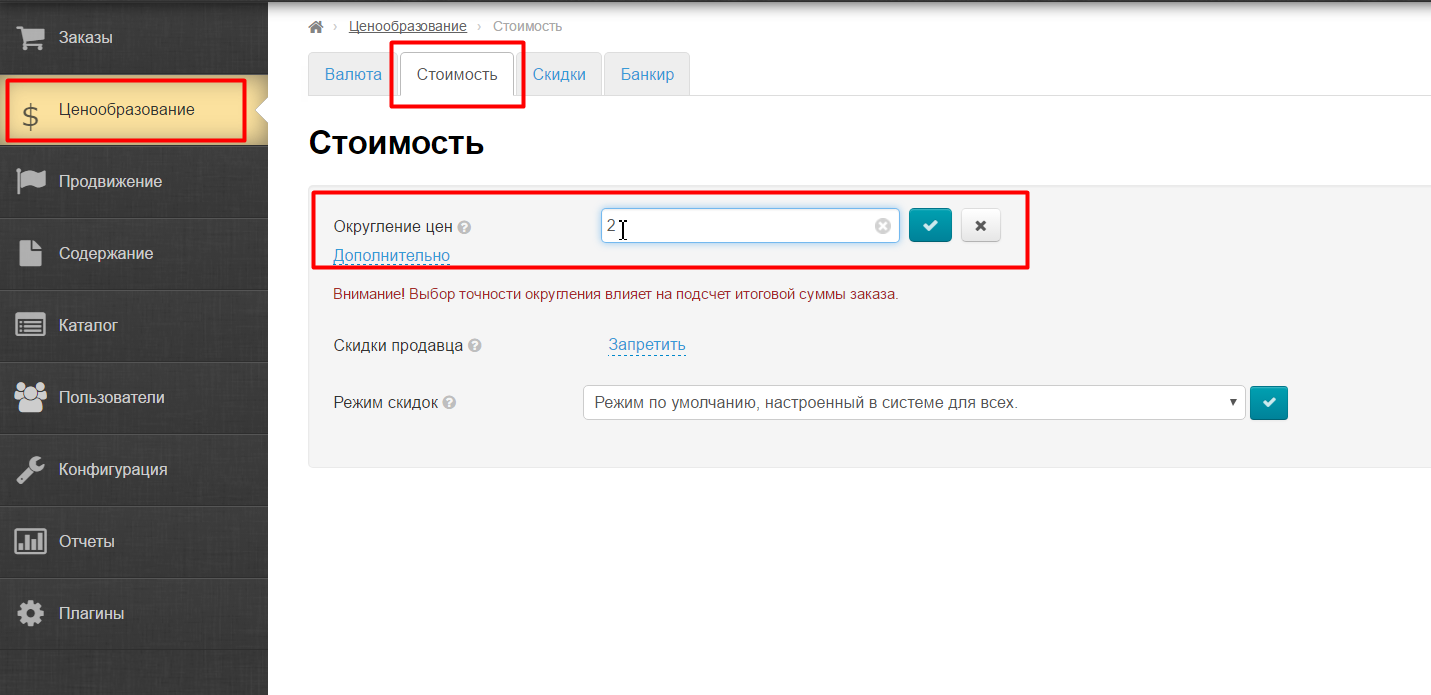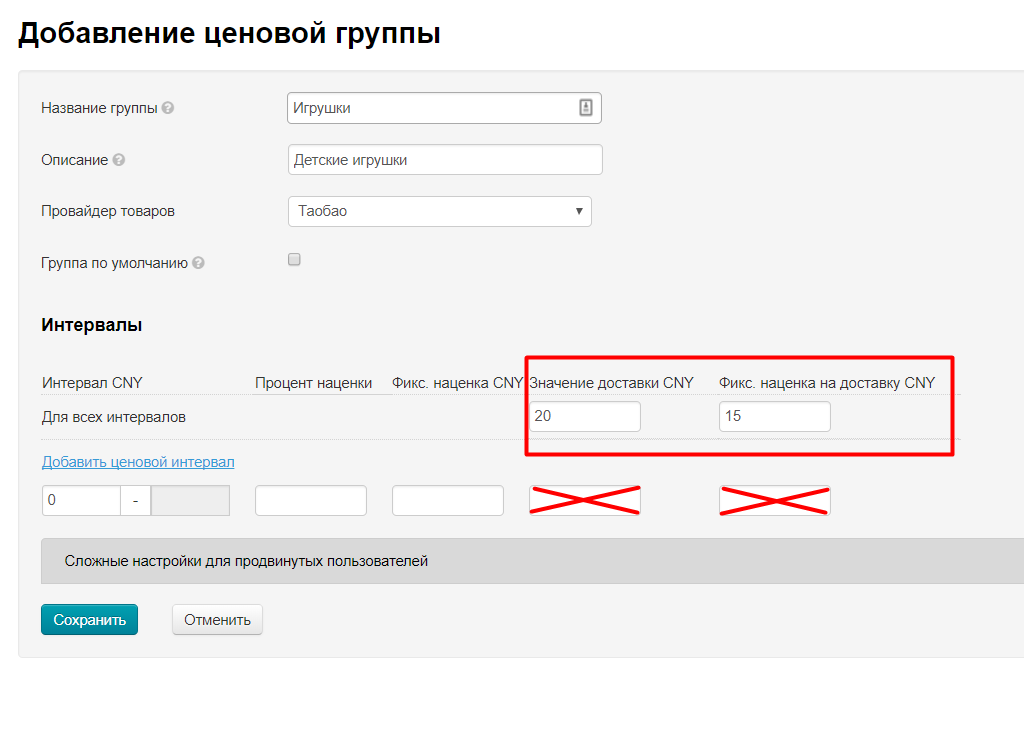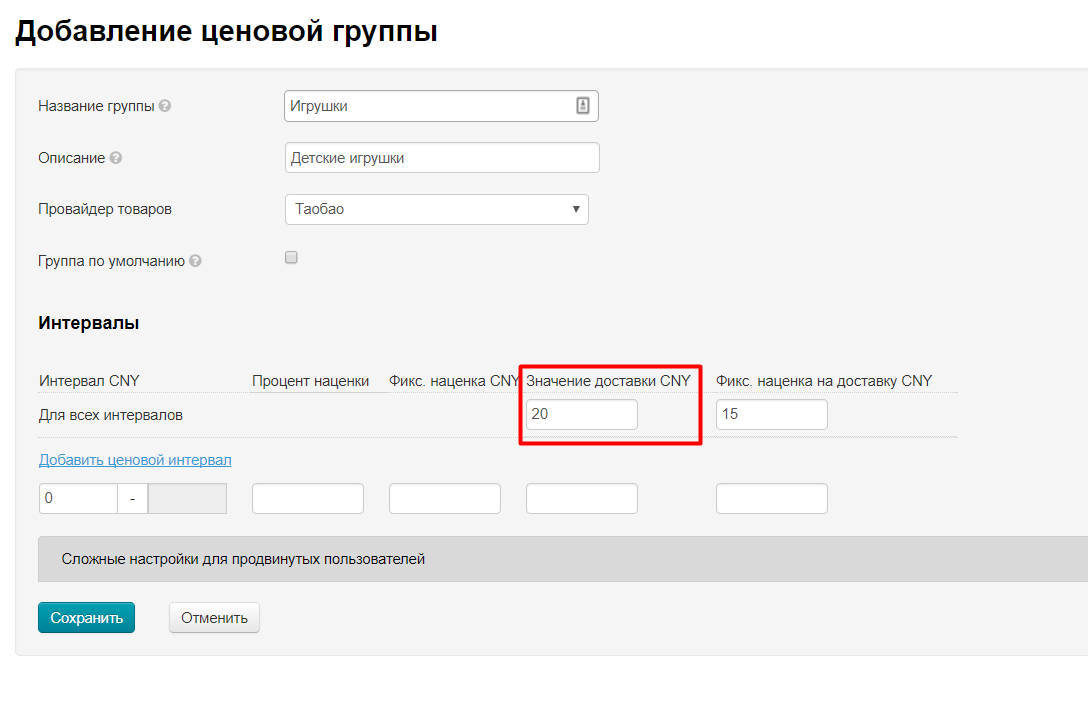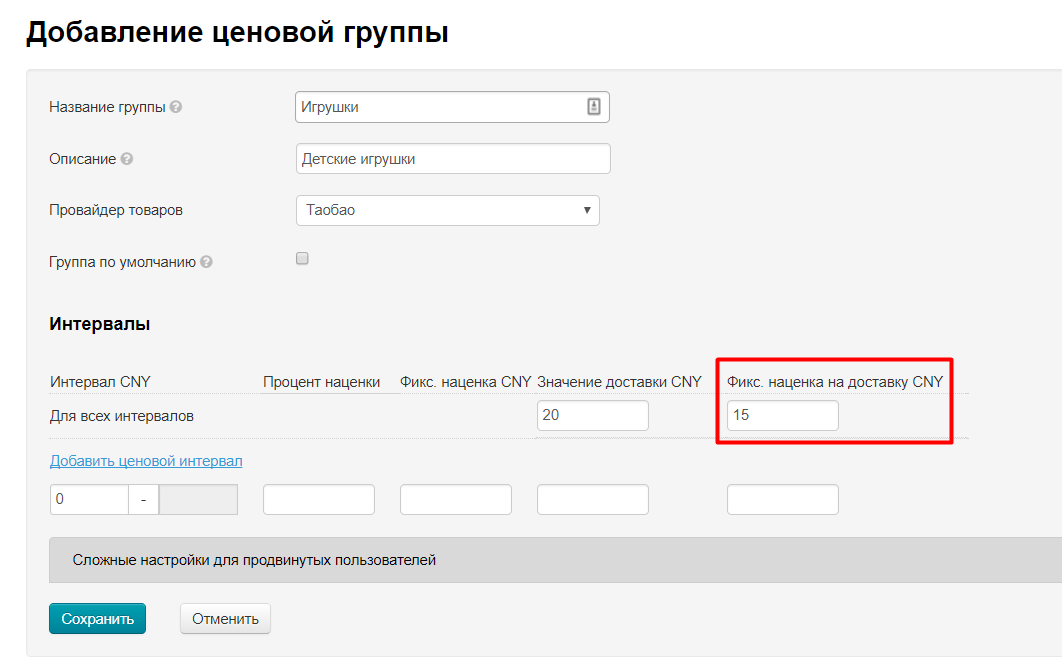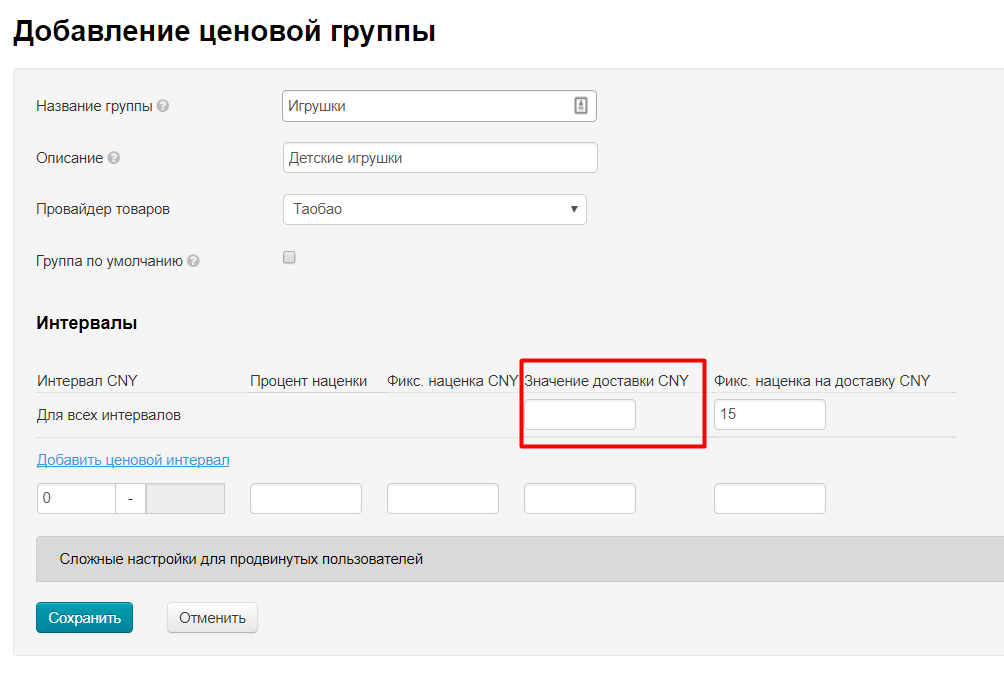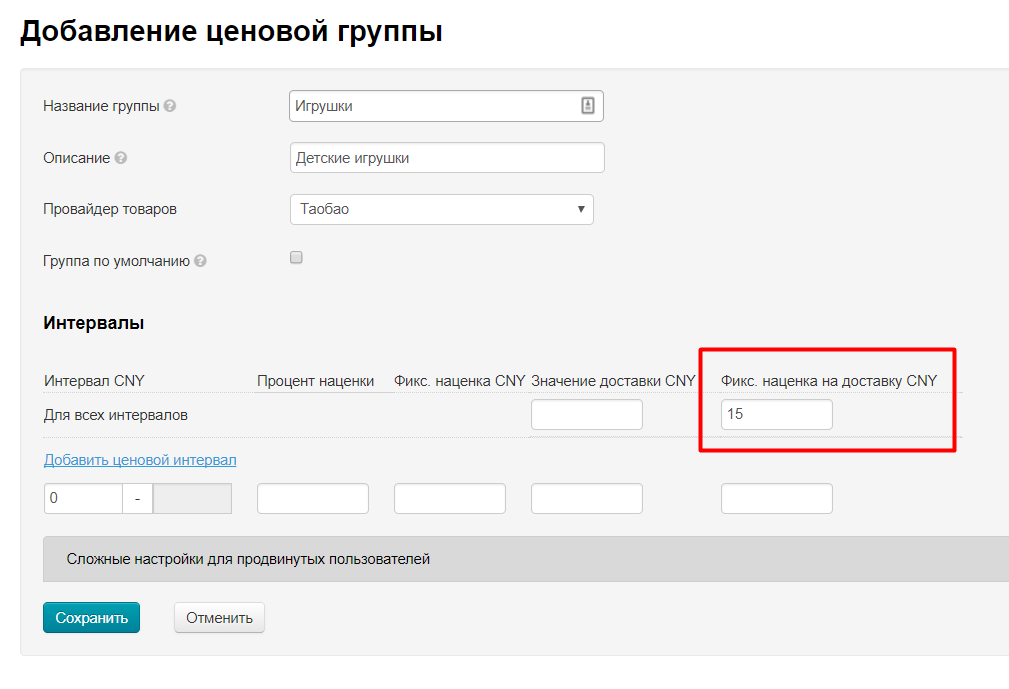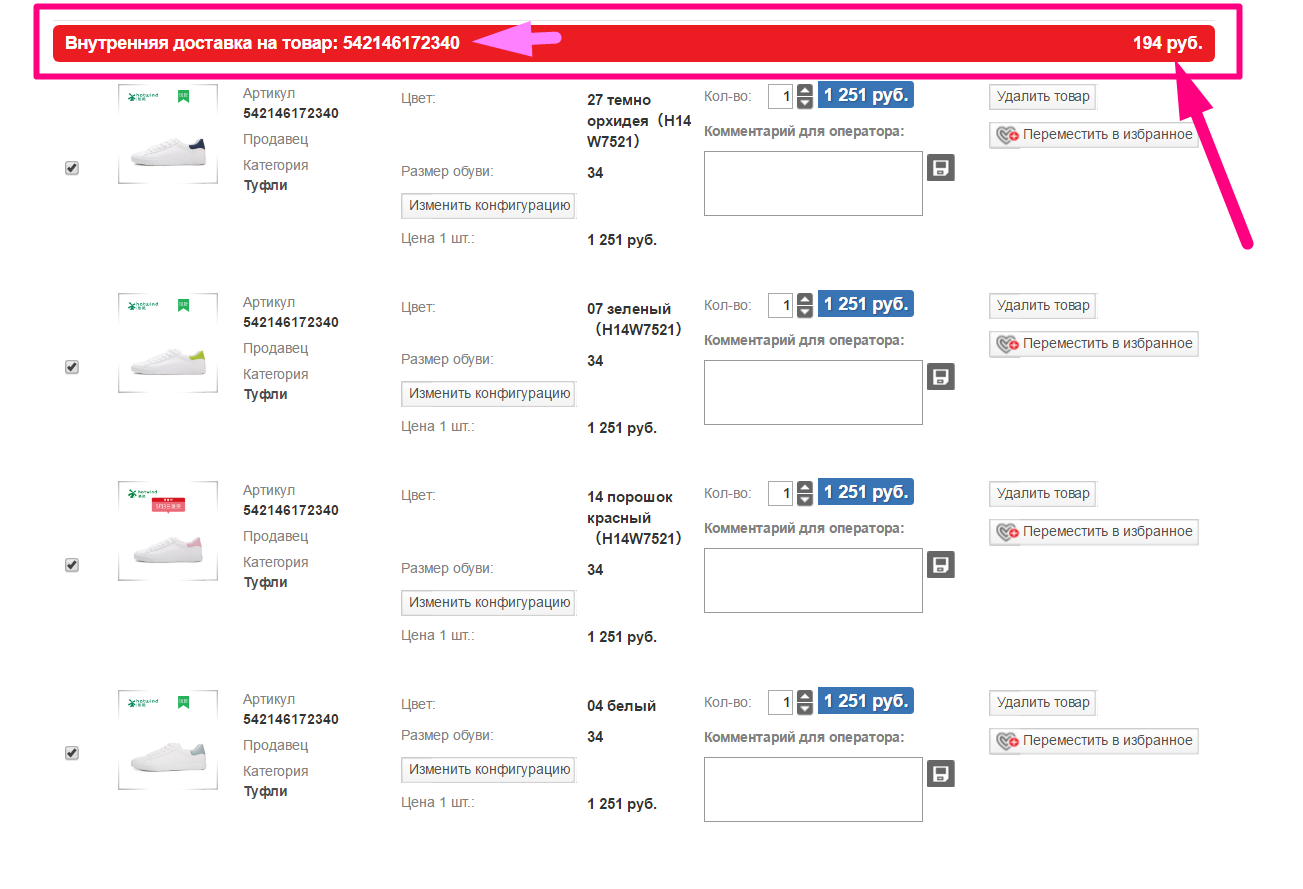Specific settings for more flexible pricing for delivery. There are both general formulas and specific formulas for a particular Commodity Provider (it will be indicated separately).
Note!
All strategies differ only in delivery calculation. They do not influence goods price.
Click triangle button "Complex settings for advanced users" to set more suitable pricing for delivery:
The choice of method for calculating delivery will be opened:
ManyIntervals
(Suitable for any trade provider)
Fixed cost is added to the total cost regardless of how many products with one code are ordered.
Let's consider how formula works step-by-step and gradually come to final calculation.
Formula uses available delivery value. It checks first if value for price interval is set:
Calculation will be done by total value of delivery if value in interval is not set:
Delivery value from trade provider (Taobao, 1688, Yahoo, etc.) is used in formula if there is no data on delivery. And the first "step" in trade provider delivery is used.
On the example of screen-shot delivery cost at this stage will be:
- 10 yuan for goods up to 100 yuan (first interval)
- 20 yuan for goods up to 1000 yuan (second interval)
When delivery is set for formula a fixed markup is added that you set for interval (the highest priority for verification) or total markup for any interval, or 0 if nothing is specified:
Thus, total delivery price (if you look at example screenshot) will be:
- 10 + 21 = 31 yuan for goods up to 100 yuan (first interval)
- 20 + 15 = 35 yuan for goods up to 1000 yuan (second interval)
ManyIntervalsWithDeliveryPerOneItem
(Suitable for any trade provider)
Fixed (or original) delivery price is added to each product.
Let's consider how formula works step-by-step and gradually come to final calculation.
Formula uses available delivery value. It checks first if value for price interval is set:
Calculation will be done by total value of delivery if value in interval is not set:
Delivery value from trade provider (Taobao, 1688, Yahoo, etc.) is used in formula if there is no data on delivery. And the first "step" in trade provider delivery is used.
On this example of screen-shot delivery cost at this stage will be:
- 10 yuan for goods up to 100 yuan (first interval)
- 20 yuan for goods up to 1000 yuan
Received delivery value is multiplied by number of goods. If we consider example from screenshot, then delivery value for 10 products will be:
- 10×10 = 100 yuan for goods up to 100 yuan (first interval)
- 20×10 = 200 yuan for goods up to 1000 yuan (second interval)
When delivery formula is defined and it is multiplied by the number of goods, a fixed markup is added to value obtained, which you set for interval (the highest priority for verification) or common for any interval or 0, if nothing is specified:
Thus, total delivery price for 10 goods (if you look at example screenshot) will be:
- 10×10 + 21 = 121 yuan for goods up to 100 yuan (first interval)
- 20×10 + 15 = 215 yuan for goods up to 1000 yuan (second interval)
ManyIntervalsWithDeliveryPerOneItemWithFixedMargin
(Suitable for any trade provider)
Original shipping cost is added to specified fixed shipping cost and added to each unit of product.
Let's consider how formula works step-by-step and gradually come to final calculation.
Formula uses available delivery value of trade provider, namely the first step in shipping cost (for example, the first kg of product costs 13 yuan).
On this example delivery cost at this stage will be:
- for goods up to 100 yuan (first interval): 13 yuan
- for goods up to 1000 yuan (second interval): 13 yuan
Then, it is checked whether value for price interval is indicated:
Calculation will be based on total value of delivery if value is not specified in the interval:
Thus, if we consider example from screenshot and take into account that the first kg of delivery of commodity provider costs 13 yuan, then delivery value for 1 item will be:
- 13+10 = 23 yuan for goods up to 100 yuan (first interval)
- 13+20 = 33 yuan for goods up to 1000 yuan (second interval)
Received delivery value is multiplied by number of goods. If we consider example above, then delivery value for 10 products will be:
- (13+10) ×10 = 230 yuan for goods up to 100 yuan (first interval)
- (13+20) ×10 = 330 yuan for goods up to 1000 yuan (second interval)
When delivery is defined for formula and multiplied by number of items, a fixed markup is added to value obtained, which you set for interval (highest priority for verification) or common for any interval:
Thus, total delivery price (if you look at example screenshot and take into account all previous calculations using this formula) will be:
- for goods up to 100 yuan (first interval): (13+10)×10 + 21 = 251 yuan
- for goods up to 1000 yuan (second interval): (13+20)×10 + 15 = 345 yuan
ManyIntervalsWithDeliveryPerKilogramm
(Suitable for any trade provider)
This formula takes into account goods weight. Fixed delivery is multiplied by weight of 1 unit of product.
Let's consider how formula works step-by-step and gradually come to final calculation.
Formula uses available delivery value first: it checks whether value for price interval is specified:
Calculation will be done by total value of delivery if value in interval is not set:
Delivery value from trade provider (Taobao, 1688, Yahoo, etc.) is used in formula if there is no data on delivery. And the first "step" in trade provider delivery is used.
Thus, delivery price (if you look at example screenshot) on this step will be:
- 10 yuan for goods up to 100 yuan (first interval)
- 20 yuan for goods up to 1000 yuan (second interval)
Product weight is checked for further calculation. It is checked first whether there is real weight or not (from trade provider). Secondly, approximate weight (Metrologist module) is checked if real one is absent. Thirdly, product weight is equal to 1 kg if approximate one is absent.
Thus, delivery price on this step will be (if 1 product = 1kg):
- 10×1 = 10 yuan for goods up to 100 yuan (first interval)
- 20×1 = 20 yuan for goods up to 1000 yuan (second interval)
Quantity of goods is taken into account further. This number is multiplied with weight, therefore, shipping cost calculation for 10 products will look different:
- 10×1×10 = 100 yuan for goods up to 100 yuan (first interval)
- 20×1×10 = 200 yuan for goods up to 1000 yuan (second interval)
When delivery is defined for formula, fixed markup is added that you set for interval (highest priority for verification) or general for any interval or 0 if nothing is specified:
Thus, total delivery price (if you look at example screenshot and take into account all previous calculations using this formula) will be:
- 10×1×10 + 21 = 121 yuan for goods up to 100 yuan (first interval)
- 20×1×10 + 15 = 215 yuan for goods up to 1000 yuan (second interval)
ManyIntervalsWithDeliveryPerRoundedKilogramm
(Suitable for any trade provider)
Calculation takes into account weight of goods, rounded to even kilograms. Total weight of all goods with one article is rounded off.
Let's consider how formula works step-by-step and gradually come to final calculation.
Formula uses available delivery value first: it checks whether value is indicated for price range:
Calculation will be done by total value of delivery if value in interval is not set:
Delivery value from trade provider (Taobao, 1688, Yahoo, etc.) is used in formula if there is no data on delivery. And the first "step" in trade provider delivery is used.
Thus, delivery price (if you look at example screenshot) on this step will be:
- 10 yuan for goods up to 100 yuan (first interval)
- for goods up to 1000 yuan (second interval): 20 yuan
Product weight is checked for further calculation. It is checked first whether there is real weight or not (from trade provider). Secondly, approximate weight (Metrologist module) is checked if real one is absent. Thirdly, product weight is equal to 1 kg if approximate one is absent.
Thus, delivery price on this step will be (if 1 product = 0,47 kg):
- 10×0,47 = 4,7 yuan for goods up to 100 yuan (first interval)
- 20×0,47 = 9,4 yuan for goods up to 1000 yuan (second interval)
Quantity of goods is taken into account further. This number is multiplied with weight and rounded to a larger side, so for 10 products shipping cost calculation will look different in this calculation.
First 0,47×10 = 4,7 ≈ 5. Then it is rounded 0,47×10 = 4,7 ≈ 5 and is used in formula:
- 10 × ((0,47×10) ≈ 5) = 50 yuan for goods up to 100 yuan (first interval)
- 20 × ((0,47×10) ≈ 5) = 100 yuan for goods up to 1000 yuan (second interval)
When delivery is defined for formula, fixed markup is added that you set for interval (highest priority for verification) or general for any interval or 0 if nothing is specified:
Thus, total delivery price (if you look at example screenshot and take into account all previous calculations using this formula) will be:
- 10 × ((0,47×10) ≈ 5) + 21 = 71 yuan for goods up to 100 yuan (first interval)
- 20 × ((0,47×10) ≈ 5) + 15 = 115 yuan for goods up to 1000 yuan (second interval)
AdvancedDeliveryByQuantityIfNoWeight
(Used only for Taobao and set by default)
It calculates internal delivery by weight if set by seller or by quantity as Taobao.
Let's consider how formula works step-by-step and gradually come to final calculation.
It is important whether delivery value (total and / or intervals) is specified:
Delivery value is specified
Delivery value will be used for calculation if it is specified. Delivery value will be also used if the trade provider did not specify delivery value by weight steps.
It is checked first whether value for price range is specified:
Calculation will be done by total value of delivery if value in interval is not set:
Delivery price (if you look at example screenshot) on this step will be:
- 10 yuan for goods up to 100 yuan (first interval)
- 20 yuan for goods up to 1000 yuan (second interval)
Received delivery value is multiplied by number of goods. If we consider example from screenshot, then delivery value for 10 products will be:
- 10×10 = 100 yuan for goods up to 100 yuan (first interval)
- 20×10 = 200 yuan for goods up to 1000 yuan (second interval)
When delivery is defined for formula, fixed markup is added that you set for interval (highest priority for verification) or general for any interval or 0 if nothing is specified:
Thus, total delivery price (if you look at example screenshot) for 10 goods will be:
- 10×10 + 21 = 121 yuan for goods up to 100 yuan (first interval)
- 20×10 + 15 = 215 yuan for goods up to 1000 yuan (second interval)
Delivery value is NOT specified
Delivery value provided by provider itself (Taobao, 1688, Yahoo, etc.) is used in the formula if it is not specified (or selected goods do not fall under the influence of existing price groups). And calculation of weight by "steps" in provider delivery is used (for example, the first kg is 7 yuan, each subsequent kg is 5 yuan - this rate depends on commodity provider).
Real weight is checked and product weight is equal to 1 kg if real one is absent.
Delivery price on this step (on the example of this calculation) will be ((for example, the first kg is 7 yuan, each subsequent kg is 5 yuan):
- 7 yuan for goods with weight 0,5 kg
- 7 yuan for goods with unknown weight
Received delivery value is multiplied by number of goods and delivery depends on delivery step cost. If we consider example from screenshot, then delivery value for 10 products will be:
- for goods with weight 0,5 kg: 0,5 × 10 = 5 kg → (first kg is 7 yuan, subsequent 4 kg by 5 yuan) → 7 + 4×5 = 27 yuan.
- for goods with unknown weight : 1×10 = 10 kg → (first kg is 7 yuan, subsequent 9 kg by 5yuan) → 7 + 9×5 = 52 yuan.
When delivery is defined for formula, fixed markup is added that you set for interval (highest priority for verification) or general for any interval or 0 if nothing is specified:
Thus, total delivery price (if you look at example screenshot) for 10 goods will be:
- for goods with weight 0,5 kg and price up to 100 yuan: 0,5 × 10 = 5 kg → (first kg is 7 yuan, subsequent 4 kg by 5 yuan) → 7 + 4×5 = 27 + 21 = 48 yuan.
- for goods with unknown weight and price more than 100 yuan: 1×10 = 10 kg → (first kg is 7 yuan, subsequent 9 kg by 5yuan) → 7 + 9×5 = 52 + 15 = 67 yuan.
AdvancedDelivery
(Used only for Taobao)
Fixed delivery price is added to each unit of the product, taking into account its weight. Goods weight is taken into account if seller set shipping cost by weight steps (that is, delivery cost of the first kg and subsequent kg).
Let's consider how formula works step-by-step and gradually come to final calculation.
It is important whether delivery value (total and / or intervals) is specified:
Delivery value is specified
If delivery value is set, this value will be used for calculations. Also, delivery value will be used if trade provider did not specify delivery value for weight steps.
It is checked first if value for price interval is specified:
Calculation will be done by total value of delivery if value in interval is not set:
Delivery price (if you look at example screenshot) on this step will be:
- 10 yuan for goods up to 100 yuan (first interval)
- 20 yuan for goods up to 1000 yuan (second interval)
Received delivery value is multiplied by number of goods. If we consider example from screenshot, then delivery value for 10 products will be:
- 10×10 = 100 yuan for goods up to 100 yuan (first interval)
- 20×10 = 200 yuan for goods up to 1000 yuan (second interval)
When delivery is defined for formula, fixed markup is added that you set for interval (highest priority for verification) or general for any interval or 0 if nothing is specified:
Thus, total delivery price (if you look at example screenshot) for 10 goods will be:
- 10×10 + 21 = 121 yuan for goods up to 100 yuan (first interval)
- 20×10 + 15 = 215 yuan for goods up to 1000 yuan (second interval)
Delivery value is NOT specified
If delivery value is NOT specified (or selected goods do not fall under the influence of existing price groups), delivery value from trade provider (Taobao, 1688, Yahoo, etc.) is used in formula. And calculation of weight by "steps" in provider delivery is used (for example, the first kg is 7 yuan, each subsequent kg is 5 yuan - this rate depends on commodity provider).
Real weight is checked and product weight is equal to the First step of delivery (if the First step is 1 kg then product weight will be 1 kg, if the first step is o,5 kg the product weight will be 0,5 kg).
Delivery price on this step (on the example of this calculation) will be (for example, rate: first kg 7 yuan, each subsequent kg is 5 yuan)
- 7 yuan for goods with weight 0,5 kg
- 7 yuan for goods with unknown weight
Received delivery value is multiplied by number of goods and delivery depends on delivery step cost. If we consider example from screenshot, then delivery value for 10 products will be:
- for goods with weight 0,5 kg: 0,5 × 10 = 5 kg → (first kg is 7 yuan, subsequent 4 kg by 5 yuan) → 7 + 4×5 = 27 yuan.
- for goods with unknown weight : 1×10 = 10 kg → (first kg is 7 yuan, subsequent 9 kg by 5yuan) → 7 + 9×5 = 52 yuan.
When delivery is defined for formula, fixed markup is added that you set for interval (highest priority for verification) or general for any interval or 0 if nothing is specified:
Thus, total delivery price (if you look at example screenshot) for 10 goods will be:
- for goods with weight 0,5 kg and price up to 100 yuan: 0,5 × 10 = 5 kg → (first kg is 7 yuan, subsequent 4 kg by 5 yuan) → 7 + 4×5 = 27 + 21 = 48 yuan.
- for goods with unknown weight and price more than 100 yuan: 1×10 = 10 kg → (first kg is 7 yuan, subsequent 9 kg by 5yuan) → 7 + 9×5 = 52 + 15 = 67 yuan.
AdvancedDeliveryPerVendor
(Used only for Taobao)
Delivery according to Taobao rules: calculates total delivery to all goods of one seller. Final delivery cost is displayed in the cart. Local delivery cost is also indicated on the item card, but it does not change with the quantity of goods and is used for informational purposes only.
Important condition
With this strategy, prices will vary depending on the number of ordered of goods and selected rounding.
Go to "Price" tab to set rounding:
Price rounding is an important setting for correct display of delivery costs by sellers! Rounding always happens for the most part, so it is not only convenient for buyers, but also beneficial for you.
Let's consider how formula works step-by-step and gradually come to final calculation.
What is important is whether delivery value "General for all intervals" was specified. Value by intervals is not taken into account:
Delivery value is specified
Delivery value will be used for calculation if it is specified (value by intervals is not taken into account:).
If we consider example from screenshot, then delivery value of all goods in the cart on this step will be 20 yuan.
Fixed markup is added to the value obtained (no mark-up is taken into account for the individual intervals) when delivery is determined for the formula.
Fixed Mark will be added to the total delivery of each seller, whose goods at the time of the calculation are in the Buyer’s cart since goods are combined in the cart by sellers.
Thus, if you look at the example of a screenshot, the total cost of delivery for one seller will be:
- 20 + 15 = 35 yuan.
Delivery value is NOT specified
If Delivery value is NOT specified (or selected goods do not fall under the influence of existing price groups), delivery value from trade provider (Taobao, 1688, Yahoo, etc.) is used in formula if there is no data on delivery. And calculation of weight by "steps" in provider delivery is used (for example, the first kg is 7 yuan, each subsequent kg is 5 yuan - this rate depends on commodity provider).
The total weight of the product is used (for example, 0.5 kg) for calculation. Consider calculation on the example of 10 products from one seller and Provider delivery value “first kg 7 yuan, each subsequent kg 5 yuan”:
- 0,5 × 10 = 5 kg → (first kg 7 yuan, subsequent 4 kg by 5yuan) → 7 + 4×5 = 27 yuan.
Fixed Markup is added to the resulting value when delivery is determined for the formula and multiplied by number of goods.
Thus, if you look at the example of a screenshot, the total cost of delivery of 10 goods of one seller will be:
- for goods of one seller: 0,5 × 10 = 5 kg → (first kg 7 yuan, subsequent 4 kg by 5yuan) → 7 + 4×5 = 27 + 21 = 48 yuan.
CalculatedDeliveryPerItem
(Used only for 1688)
Delivery according to the rules of 1688: calculates total delivery to all products of the same article and different configurations. Displayed in the shopping cart.
(Available for 1.7.7. and higher version of admin panel)
This formula helps to work with wholesale lots: combines goods of the same article but different configurations in the basket into one group and sets total cost of internal delivery. Delivery cost is indicated in the item card but does not affect calculation and used for informational purposes only.
Important conditions:
- goods should have one article.
- goods can have different configurations (within the same article, for example: color, size, equipment)
What is important is whether delivery value "General for all intervals" was specified. Setting separately for intervals is not taken into account:
Delivery value is specified
Delivery value will be used for calculation if it is specified. (value by intervals is not taken into account:).
If we consider example from screenshot, then delivery value of all goods in the cart with one article on this step will be 20 yuan.
Fixed markup is added to the value obtained (no mark-up is taken into account for the individual intervals) when delivery is determined for the formula.
Fixed Mark will be added to the total delivery of each single article, whose goods at the time of the calculation are in the Buyer’s cart since goods are combined in the cart by articles.
Thus, if you look at the example of a screenshot, the total cost of delivery of one article (but different configurations) will be:
- 20 + 15 = 35 yuan.
Delivery value is NOT specified
If delivery value is NOT specified (or selected goods do not fall under the influence of existing price groups), delivery value from trade provider (Taobao, 1688, Yahoo, etc.) is used in formula if there is no data on delivery, based on the number of products of the same article that have been selected. For example, delivery of 10 goods of one article will be 37 yuan.
Fixed Markup is added to the resulting value when delivery is determined for the formula:
diffierent
Thus, if you look at the example of a screenshot, the total cost of delivery of 10 goods of one article (but different configurations) will be:
- 37 + 15 = 52 yuan.
